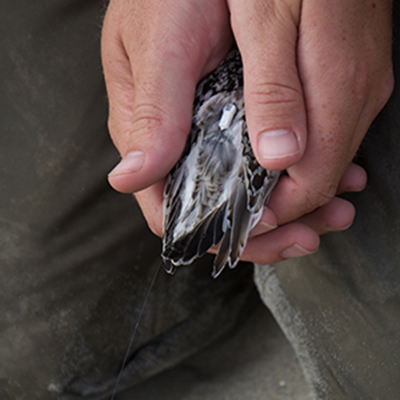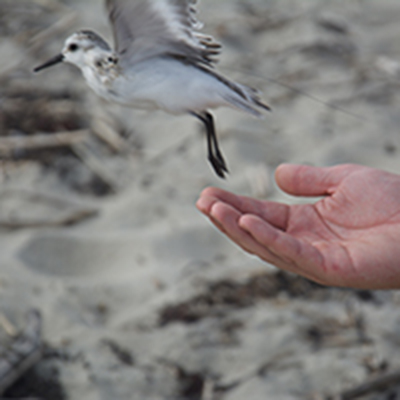Marine Birds: Tracking Shorebird Migration
Arctic breeding shorebird populations are declining at an alarming rate. Habitat loss and degradation are thought to be important factors in this decline. This project, led by Maine Department of Inland Fisheries and Wildlife (IF&W), and in collaboration with the University of Maine, Environment Canada, USFWS Parker River NWR, USFWS Rachel Carson NWR, and Biodiversity Research Institute, aims to identify critical migration stopover sites in the Gulf of Maine, a major flyway for many shorebird species, and to better understand the characteristics of these sites and how well they provide shorebirds with the necessary resources to rest and refuel. This information is critical for developing effective plans for managing and conserving valuable habitats for these species.
Project Overview

This project employs state-of-the-art tracking technology to document local and regional scale movements of shorebird species using beach and saltmarsh habitats at Rachel Carson NWR in Wells, ME, and Popham Beach State Park in Phippsburg, ME.
Project Components

Ultra-light VHF tags called nanotags are being attached primarily to Semipalmated Sandpipers. The nanotag transmitters emit a signal that can be picked up continuously by an array of 50 automated telemetry receiver towers located at the study sites and placed strategically throughout the Gulf of Maine, as well as a larger network of as many as 100 towers located along the Atlantic coast from Newfoundland to Virginia. Other individuals receive a uniquely marked colored leg flag and color bands that can be seen by birdwatchers. Resightings of these birds provide additional information on shorebird movements.
In addition, a subset of birds has a small blood sample collected that will be analyzed to provide information about the general condition, health, and energetic state of the bird. The information gained from this study is improving our knowledge of local and regional scale movements, habitat selection, stopover length, impacts to migrating shorebirds from human related disturbance, and basic health of shorebirds migrating through the Gulf of Maine and beyond.
Project Team

Project managed and coordinated by Lindsay Tudor (MDIFW) and Rebecca Holberton (UMaine).
Team Members: Kate O’Brien (USFWS-RCNWR); Melissa Duron, Sarah Johnson, Patrick Keenan, Dana Palm, Kevin Regan, Lucas Savoy, Iain Stenhouse (BRI)
Collaborators and Funding

Collaborators: University of Maine; Environment Canada; Parker River NWR; Maine Coastal Islands NWR; Rachel Carson NWR; Biodiversity Research Institute; Maine Department of Agriculture, Conservation, and Forestry Bureau of Parks and Public Lands
Funding: This project was funded by a Maine IF&W State Wildlife Grant; the University of Maine – Maine Agricultural and Forest Experimental Station; the Maine Outdoor Heritage Fund; and U.S. Fish and Wildlife Service, Region 5 Refuges.


